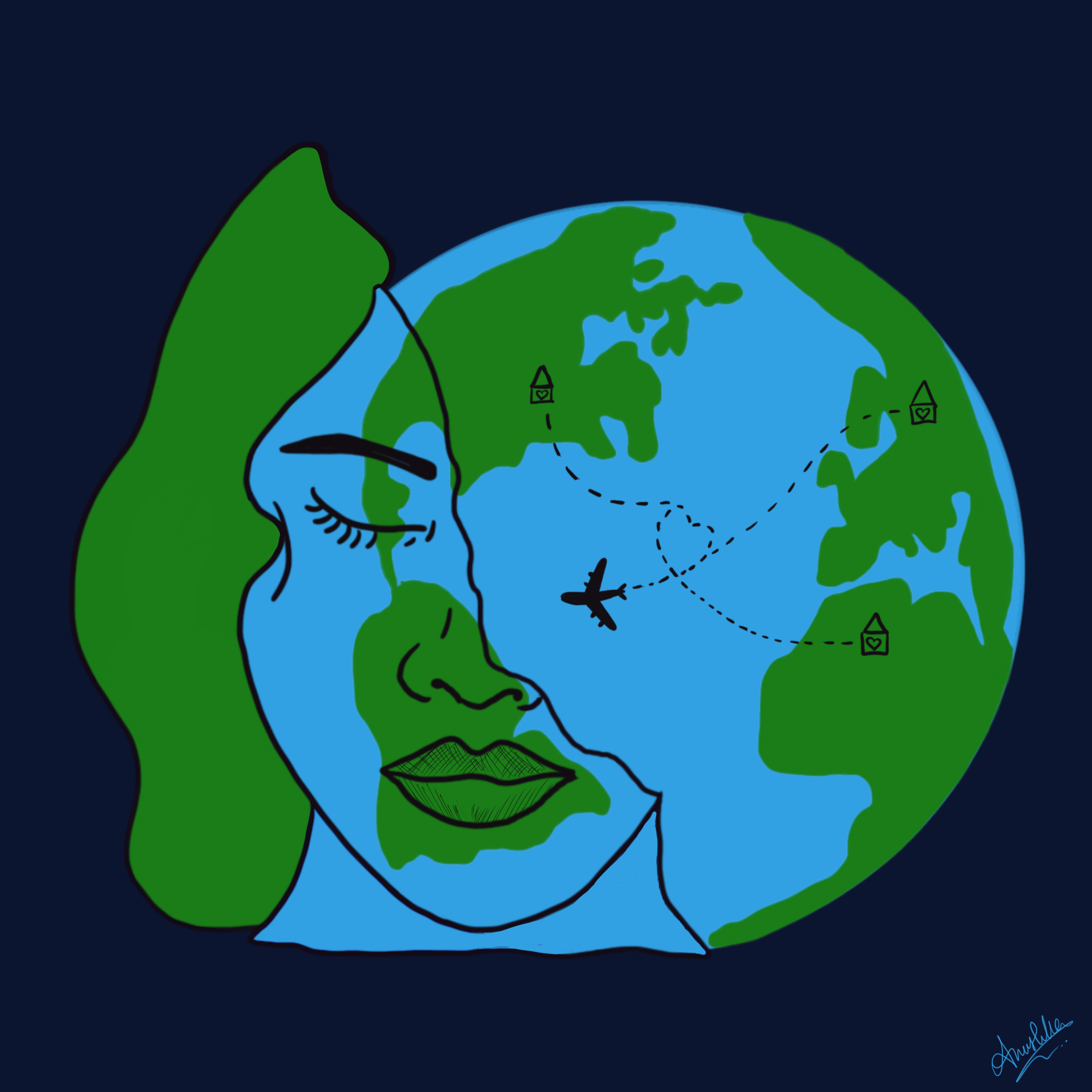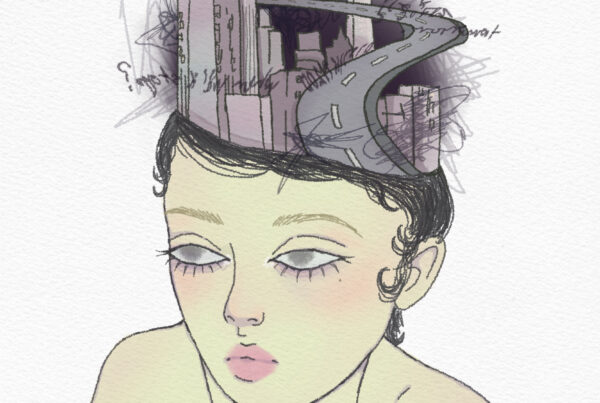
I used to call myself a first generation Canadian, as in the first generation of my family born in Canada, only to find out the ‘proper’ term is second-generation immigrant, as in born in the country but still an immigrant. This realization led me to reflect more deeply on how immigrants negotiate their roles and spaces within society, and on my own experience.
I used to call myself a first generation Canadian, as in the first generation of my family born in Canada, only to find out the ‘proper’ term is second-generation immigrant, as in born in the country but still an immigrant. This realization led me to reflect more deeply on how immigrants negotiate their roles and spaces within society, and on my own experience.

Illustration by Anushka Sabhanam

Illustration by Anushka Sabhanam
Navigating the complexities of identity within the context of multiculturalism has been an important part of my life. Multiculturalism, a political ideology addressing how ethnic groups in a society maintain their cultural distinctiveness, became an official government policy in my home country of Canada in the 1970s. In grade school, I was taught that our differences are what made us special, and although we came from different countries, we could live together in peace. This was a welcome message because, like many other Canadians, I was a child of immigrants. In the late 1980s, my parents left Poland to migrate to Canada. I was born shortly after into a family that spoke no English and was raised in the Polish community in a town just outside Toronto. I went to a Polish church, shopped at Polish grocery stores, watched Polish cartoons, and spent nearly all my time around Polish people. For the first five years of my life, until I went to school, I was Polish.
My experience is a common one in Canada. According to the last Canadian census, 17.6% of Canadians are second-generation (Immigrant Generation, 2021), a figure set to increase with the government’s plan to attract 500,000 new permanent residents annually for the next 3 years (Government of Canada, 2022). Similar trends unfold globally. In the US, about 25 million adults are American-born children of immigrants, representing about 10 % of the adult population (Taverjnise, 2020). The Netherlands also reflects this pattern, with 11.4% of its 17.5 million residents as of 2021 were children of at least one immigrant (Statistics Netherlands, 2022). As many societies see a rise in immigration and increased diversification, it is valuable to examine how immigrants settle and adapt to a new society.
In recent years, the concept of acculturation has been used to examine this issue. In essence, acculturation refers to the changes that occur when people of different cultures come into contact with each other. This theory posits four approaches through which immigrants and their children build lives in a new culture:
1) Assimilation occurs when individuals have no desire to maintain their heritage culture and instead adopt the culture of the majority.
2) Integration involves a desire to maintain one’s heritage culture while actively engaging with the dominant culture.
3) Separation happens when there is a strong desire to maintain heritage culture while distancing oneself from the culture of the larger society,
4) Marginalization occurs when there is both no desire to maintain heritage culture and also an avoidance of larger society. (Sam & Berry, 2006)
Is there an ideal path for migrants and their children? Research consistently reveals that those in the integration group have the highest scores on life satisfaction, mental health, and well-being, while those in the marginalization group had the lowest scores on both, with assimilation and separation falling in between (Berry & Hou, 2019; Berry & Hou, 2017) This integrated group not only enjoys positive psychological well-being but also demonstrates better adjustment in school and the broader community, as well as reporting the least amount of discrimination (Barry & Sabatier, 2010; Giuliani et al. 2018). These findings emphasize the crucial role in fostering a sense of belonging among immigrants and their children, not only within their heritage culture but also within the dominant culture. In a study with over 7000 first-generation immigrants in Canada, Berry and Hou (2017) found that over 60% were in the integration group, a finding backed by other research. A similar preference for integration can be found in various countries (Sam & Berry 2006). In short, embracing both heritage and dominant cultures is vital for the well-being and successful adaptation of immigrants and their descendants.
This line of thought adds complexity to the discussion. The assumption behind the four strategies implies that immigrants can choose their paths, but the reality is more nuanced, as dominant society can influence these choices. Canada is considered a ‘settler country,’ and multiculturalism is a part of the political and cultural foundation. In contrast to many European countries, such as France and the Netherlands, that have more assimilationist policies emphasizing the adoption of the language, customs, and values of the majority. What kind of effect could this difference in approach have? Bélanger and Verkuyten (2010) looked into the identities of second-generation citizens of Chinese descent in Canada and the Netherlands. They found that 42% of participants in the Netherlands do not identify with the Dutch national identity, compared to 24% in Canada who don’t identify with Canadian national identity. The authors concluded that “ The civic discourse of being Canadian appeared to be more supportive of hyphenated identities.” This observation aligns with the findings of Barry et al. (2006), revealing that the higher the degree of policy support for cultural diversity, the higher the integration and assimilation orientations of immigrant youth, and the higher the level of sociocultural adaptation.
“In grade school, I was taught that our differences are what made us special, and although we came from different countries, we could live together in peace.”
Another complicating factor in acculturation is discrimination, particularly for groups that are visibly different or hold distinct views, such as religious beliefs. The experience of discrimination significantly influences the acculturation strategies individuals may adopt. Perceived discrimination has been linked to poorer mental health outcomes, such as greater incidence of depression and lower self-esteem, among second generation youths in a variety of countries (Giuliani et al, 2018). For the second-generation, discrimination is negatively associated with national identity and positively associated with ethnic and religious identities. It also presents a greater obstacle for certain groups. A German study revealed more pressure for assimilation placed on the second-generation, particularly ‘devalued’ groups (Turks) than on ‘valued’ groups (Poles) (Kunst & Sam, 2014). These findings highlight the relationship between discrimination, acculturation, and societal expectations.
“The concept of acculturation has offered me a better understanding not only of my experience but also that of those around me.”
Applying these ideas to my own life leaves me with a mix of emotions. On the one hand, it’s frustrating that my experiences as a second-generation immigrant can be compacted into predefined categories, potentially overlooking the intricacies of my journey. Reflecting on my life, as well as those of my family and friends, I see individuals who spent years translating language and culture for their families, taking on adult roles to fill the cultural knowledge gap of their parents, and experiencing shame over our parent’s stereotypically immigrant jobs and their limited English skills. These diverse experiences challenge the oversimplification inherent in categorical frameworks.
On the other hand, I find some comfort in this theory. I once read somewhere that Canada was a nation of hyphens (Polish-Canadian, Nigerian-Canadian). When I was younger, I could never figure out how someone was supposed to be two things at once so I decided that I would call myself neither. The concept of acculturation has offered me a better understanding not only of my experience but also that of those around me. Consider my family: My father moved to Canada at age 30, having spent the first three decades of his life living happily in Poland. Struggling to embrace Canadian culture, or maybe feeling that Canada never fully embraced him, he still feels like a stranger in the country he has called home for over 30 years. My mother moved to Canada at 20. Coming from the poorest part of Poland, she recognizes the positive impact Canada has had on her life. She now speaks nearly fluent English and has embraced Canada, while still maintaining a connection with her native culture. My brother shows little interest in having a hyphenated cultural identity and chooses not to engage with our family’s culture outside the home. As for me, I have come to appreciate the value of embracing both sides of my identity – referring to myself as both Canadian and Polish, allowing me to recognize the richness that comes from embracing two cultures, appreciating the unique strengths that emerge from the intersection of these diverse influences. <<
References
– Bélanger, E., & Verkuyten, M. (2010). Hyphenated Identities and Acculturation: Second-Generation Chinese of Canada and the Netherlands. Identity, 10(3), 141–163. https://doi.org/10.1080/15283488.2010.495906
– Berry, J. W., & Hou, F. (2017). Acculturation, Discrimination and Wellbeing among Second Generation of Immigrants in Canada. International Journal of Intercultural Relations, 61, 29–39. https://doi.org/10.1016/j.ijintrel.2017.08.003
– Berry, J. W., & Hou, F. (2019). Multiple belongings and psychological well-being among immigrants and the second generation in Canada. Canadian Journal of Behavioural Science, 51(3), 159–170. https://doi.org/10.1037/cbs0000130
– Berry, J.W., & Sabatier, C. (2010). Acculturation, Discrimination, and Adaptation Among Second Generation Immigrant Youth in Montreal and Paris. International Jounrnal of Intercultural Relations, 34, 191-207. doi:10.1016/j.ijintrel.2009.11.007
– Immigrant generation. (2021). https://censusmapper.ca/maps/3608#8/42.912/-81.323
– Government of Canada. (2022, November 1). An Immigration Plan to Grow the Economy. https://www.canada.ca/en/immigration-refugees-citizenship/news/2022/11/an-immigration-plan-to-grow-the-economy.html
– Kunst, J. R., & Sam, D. L. (2014). “It’s on Time That They Assimilate” – Differential Acculturation Expectations towards First and Second Generation Immigrants. International Journal of Intercultural Relations, 39, 188–195. https://doi.org/10.1016/j.ijintrel.2013.10.007
– Sam, D. L., & Berry, J. W. (2006). The Cambridge Handbook of Acculturation Psychology. In Cambridge University Press eBooks. https://doi.org/10.1017/cbo9780511489891
– Statistics Netherlands (2022, March 18). 5. The New Classification in Figures. Statistics Netherlands. https://www.cbs.nl/en-gb/longread/statistische-trends/2022/new-classification-of-population-by-origin/5-the-new-classification-in-figures
– Tavernise, S. T. (2020, August 15). Kamala Harris, Daughter of Immigrants, Is the Face of America’s Demographic Shift. The New York Times. Retrieved December 5, 2023, from https://www.nytimes.com/2020/08/15/us/second-generation-immigrant-kamala-harris.html
Navigating the complexities of identity within the context of multiculturalism has been an important part of my life. Multiculturalism, a political ideology addressing how ethnic groups in a society maintain their cultural distinctiveness, became an official government policy in my home country of Canada in the 1970s. In grade school, I was taught that our differences are what made us special, and although we came from different countries, we could live together in peace. This was a welcome message because, like many other Canadians, I was a child of immigrants. In the late 1980s, my parents left Poland to migrate to Canada. I was born shortly after into a family that spoke no English and was raised in the Polish community in a town just outside Toronto. I went to a Polish church, shopped at Polish grocery stores, watched Polish cartoons, and spent nearly all my time around Polish people. For the first five years of my life, until I went to school, I was Polish.
My experience is a common one in Canada. According to the last Canadian census, 17.6% of Canadians are second-generation (Immigrant Generation, 2021), a figure set to increase with the government’s plan to attract 500,000 new permanent residents annually for the next 3 years (Government of Canada, 2022). Similar trends unfold globally. In the US, about 25 million adults are American-born children of immigrants, representing about 10 % of the adult population (Taverjnise, 2020). The Netherlands also reflects this pattern, with 11.4% of its 17.5 million residents as of 2021 were children of at least one immigrant (Statistics Netherlands, 2022). As many societies see a rise in immigration and increased diversification, it is valuable to examine how immigrants settle and adapt to a new society.
In recent years, the concept of acculturation has been used to examine this issue. In essence, acculturation refers to the changes that occur when people of different cultures come into contact with each other. This theory posits four approaches through which immigrants and their children build lives in a new culture:
1) Assimilation occurs when individuals have no desire to maintain their heritage culture and instead adopt the culture of the majority.
2) Integration involves a desire to maintain one’s heritage culture while actively engaging with the dominant culture.
3) Separation happens when there is a strong desire to maintain heritage culture while distancing oneself from the culture of the larger society,
4) Marginalization occurs when there is both no desire to maintain heritage culture and also an avoidance of larger society. (Sam & Berry, 2006)
Is there an ideal path for migrants and their children? Research consistently reveals that those in the integration group have the highest scores on life satisfaction, mental health, and well-being, while those in the marginalization group had the lowest scores on both, with assimilation and separation falling in between (Berry & Hou, 2019; Berry & Hou, 2017) This integrated group not only enjoys positive psychological well-being but also demonstrates better adjustment in school and the broader community, as well as reporting the least amount of discrimination (Barry & Sabatier, 2010; Giuliani et al. 2018). These findings emphasize the crucial role in fostering a sense of belonging among immigrants and their children, not only within their heritage culture but also within the dominant culture. In a study with over 7000 first-generation immigrants in Canada, Berry and Hou (2017) found that over 60% were in the integration group, a finding backed by other research. A similar preference for integration can be found in various countries (Sam & Berry 2006). In short, embracing both heritage and dominant cultures is vital for the well-being and successful adaptation of immigrants and their descendants.
This line of thought adds complexity to the discussion. The assumption behind the four strategies implies that immigrants can choose their paths, but the reality is more nuanced, as dominant society can influence these choices. Canada is considered a ‘settler country,’ and multiculturalism is a part of the political and cultural foundation. In contrast to many European countries, such as France and the Netherlands, that have more assimilationist policies emphasizing the adoption of the language, customs, and values of the majority. What kind of effect could this difference in approach have? Bélanger and Verkuyten (2010) looked into the identities of second-generation citizens of Chinese descent in Canada and the Netherlands. They found that 42% of participants in the Netherlands do not identify with the Dutch national identity, compared to 24% in Canada who don’t identify with Canadian national identity. The authors concluded that “ The civic discourse of being Canadian appeared to be more supportive of hyphenated identities.” This observation aligns with the findings of Barry et al. (2006), revealing that the higher the degree of policy support for cultural diversity, the higher the integration and assimilation orientations of immigrant youth, and the higher the level of sociocultural adaptation.
“In grade school, I was taught that our differences are what made us special, and although we came from different countries, we could live together in peace.”
Another complicating factor in acculturation is discrimination, particularly for groups that are visibly different or hold distinct views, such as religious beliefs. The experience of discrimination significantly influences the acculturation strategies individuals may adopt. Perceived discrimination has been linked to poorer mental health outcomes, such as greater incidence of depression and lower self-esteem, among second generation youths in a variety of countries (Giuliani et al, 2018). For the second-generation, discrimination is negatively associated with national identity and positively associated with ethnic and religious identities. It also presents a greater obstacle for certain groups. A German study revealed more pressure for assimilation placed on the second-generation, particularly ‘devalued’ groups (Turks) than on ‘valued’ groups (Poles) (Kunst & Sam, 2014). These findings highlight the relationship between discrimination, acculturation, and societal expectations.
“The concept of acculturation has offered me a better understanding not only of my experience but also that of those around me.”
Applying these ideas to my own life leaves me with a mix of emotions. On the one hand, it’s frustrating that my experiences as a second-generation immigrant can be compacted into predefined categories, potentially overlooking the intricacies of my journey. Reflecting on my life, as well as those of my family and friends, I see individuals who spent years translating language and culture for their families, taking on adult roles to fill the cultural knowledge gap of their parents, and experiencing shame over our parent’s stereotypically immigrant jobs and their limited English skills. These diverse experiences challenge the oversimplification inherent in categorical frameworks.
On the other hand, I find some comfort in this theory. I once read somewhere that Canada was a nation of hyphens (Polish-Canadian, Nigerian-Canadian). When I was younger, I could never figure out how someone was supposed to be two things at once so I decided that I would call myself neither. The concept of acculturation has offered me a better understanding not only of my experience but also that of those around me. Consider my family: My father moved to Canada at age 30, having spent the first three decades of his life living happily in Poland. Struggling to embrace Canadian culture, or maybe feeling that Canada never fully embraced him, he still feels like a stranger in the country he has called home for over 30 years. My mother moved to Canada at 20. Coming from the poorest part of Poland, she recognizes the positive impact Canada has had on her life. She now speaks nearly fluent English and has embraced Canada, while still maintaining a connection with her native culture. My brother shows little interest in having a hyphenated cultural identity and chooses not to engage with our family’s culture outside the home. As for me, I have come to appreciate the value of embracing both sides of my identity – referring to myself as both Canadian and Polish, allowing me to recognize the richness that comes from embracing two cultures, appreciating the unique strengths that emerge from the intersection of these diverse influences. <<



